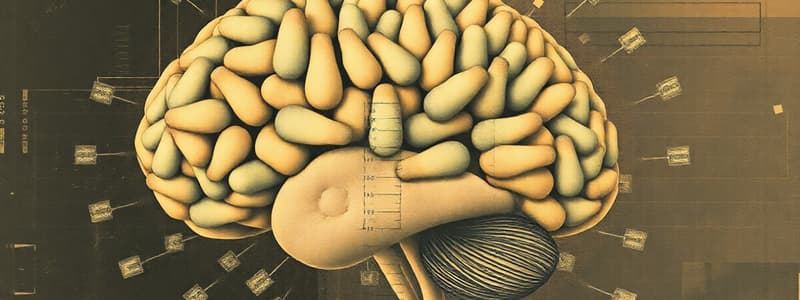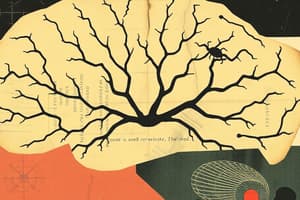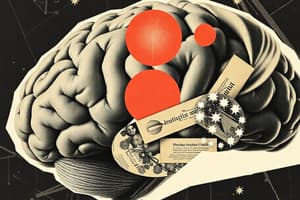Podcast
Questions and Answers
Which of the following accurately describes the function of neurotransmitters?
Which of the following accurately describes the function of neurotransmitters?
- Serve only as excitatory signals in neuronal communication.
- Are chemical substances that can create excitatory or inhibitory responses. (correct)
- Are only synthesized in the synaptic cleft.
- Function solely in the peripheral nervous system.
What is the main difference between ionotropic and metabotropic receptor actions?
What is the main difference between ionotropic and metabotropic receptor actions?
- Ionotropic receptors require G protein activation.
- Metabotropic receptors are found only in the central nervous system.
- Metabotropic receptors act through second messengers. (correct)
- Ionotropic receptors are exclusively excitatory.
In which situation would acetylcholine be considered inhibitory?
In which situation would acetylcholine be considered inhibitory?
- In cognitive functions and memory.
- In cardiac muscle function. (correct)
- In skeletal muscle contraction.
- During excitatory neurotransmission.
Which neurotransmitter is primarily associated with the regulation of pleasure and reward?
Which neurotransmitter is primarily associated with the regulation of pleasure and reward?
What is the role of acetyl-CoA in the synthesis of acetylcholine?
What is the role of acetyl-CoA in the synthesis of acetylcholine?
Which effect is associated with an excess of dopamine levels?
Which effect is associated with an excess of dopamine levels?
In myasthenia gravis, what is primarily affected in the neuromuscular junction?
In myasthenia gravis, what is primarily affected in the neuromuscular junction?
What immediate response occurs when an excitatory neurotransmitter binds to an ionotropic receptor?
What immediate response occurs when an excitatory neurotransmitter binds to an ionotropic receptor?
What is a characteristic symptom of Alzheimer's Disease related to cholinergic neurons?
What is a characteristic symptom of Alzheimer's Disease related to cholinergic neurons?
What neurotransmitter is primarily released by postganglionic neurons in the sympathetic nervous system?
What neurotransmitter is primarily released by postganglionic neurons in the sympathetic nervous system?
Which of the following is a key function of serotonin in the central nervous system?
Which of the following is a key function of serotonin in the central nervous system?
What role does norepinephrine activity play in mood regulation according to the catecholamine hypothesis?
What role does norepinephrine activity play in mood regulation according to the catecholamine hypothesis?
Which enzyme converts norepinephrine to epinephrine?
Which enzyme converts norepinephrine to epinephrine?
Which of the following receptors is inhibitory for serotonin?
Which of the following receptors is inhibitory for serotonin?
Where is serotonin primarily synthesized in the body?
Where is serotonin primarily synthesized in the body?
What is the primary mechanism by which glutamate functions as an excitatory neurotransmitter?
What is the primary mechanism by which glutamate functions as an excitatory neurotransmitter?
Which amino acid is a precursor for serotonin synthesis?
Which amino acid is a precursor for serotonin synthesis?
Which neurotransmitter is primarily involved in mood regulation and is impacted by antidepressants like Prozac?
Which neurotransmitter is primarily involved in mood regulation and is impacted by antidepressants like Prozac?
What effect does increased norepinephrine activity have in individuals?
What effect does increased norepinephrine activity have in individuals?
Flashcards are hidden until you start studying
Study Notes
Neurotransmitters
- Chemical messengers synthesized in neurons and released during neuronal excitation (dependent on calcium influx).
- Can elicit excitatory or inhibitory responses in cells or tissues.
- Act in postsynaptic, post-ganglionic, or target cells.
- Facilitate communication between neurons through chemical synapses.
- Photoreceptors are the only nerve cells active during hyperpolarization.
Functional Classification
- Excitatory: Depolarization, leading to an increase in the likelihood of a neuron firing.
- Inhibitory: Hyperpolarization, decreasing the likelihood of a neuron firing.
- Photoreceptors are an exception to this, being active during hyperpolarization.
- Direct (Ionotropic): Neurotransmitter binds to an ionotropic receptor, causing the channel to open and allowing ions to flow across the membrane. This produces an immediate response.
- Indirect (Metabotropic): Neurotransmitter binds to a metabotropic receptor, activating a G protein. This G protein then activates an effector protein, leading to the production of second messenger molecules. These messengers activate enzymes, ultimately opening ion channels and causing a more delayed and longer-lasting response compared to ionotropic receptors.
Neurotransmitter Inactivation
- Degradation by Enzymes: Enzymes present in the postsynaptic cell or synaptic cleft break down the neurotransmitter, removing it from the synapse.
- Reuptake: Glial cells (astrocytes) or the presynaptic neuron reabsorb the neurotransmitter back into the presynaptic terminal.
- Diffusion: Neurotransmitter diffuses away from the synapse into the bloodstream.
Acetylcholine (ACh)
- Functional Regulation:
- Movement
- Cortical excitability
- Heart and skeletal muscle contraction
- Arousal and sleep
- Cognition and reward
- Synthesis: Acetylcholine is synthesized from acetyl-CoA and choline by choline acetyltransferase (ChAT), the rate-limiting step in the pathway.
- Acetyl-CoA is derived from glycolysis products (pyruvate) converted by pyruvate dehydrogenase.
- Choline is obtained from reuptake after cholinesterase enzymatic degradation.
- Excitatory in skeletal muscle, inhibitory in cardiac muscle.
- Packaging: Acetylcholine is packaged into vesicles by a vesicular acetylcholine transporter (vAChT).
Dopamine (DA)
- Functional Regulation:
- Coordination and movement
- Attention, memory, and learning
- Pleasure/reward
- Arousal and sleep
- Behavior and cognition
- Inhibition of prolactin production
- Nausea and vomiting
- Inflammation and pain
- Imbalance:
- Sleep disturbances
- Restless legs syndrome
- Psychosis
- Apathy/depression
- ADHD symptoms
- Inactivation: Monoamine Oxidase (MAO) and Catechol-O-methyltransferase (COMT) inactivate dopamine in the liver, presynaptic, or post-synaptic terminal (reuptake-2).
- Receptors: Dopamine receptors are classified as D1-like (D1R and D5R) and D2-like (D2R, D3R, D4R), all G-protein coupled receptors.
- D1-like: Linked to Gs, stimulating adenyl cyclase (AC).
- D2-like: Linked to Gi/Gs, inhibiting AC and Ca2+ channels, and activating K+ channels.
Norepinephrine (NE)
- Biosynthesis: Norepinephrine is synthesized from the same pathway as dopamine, originating from phenylalanine and tyrosine amino acids.
- Functional Regulation: Various depending on the receptor type, but generally excitatory or inhibitory.
- Location:
- CNS: Brainstem (pons)- locus coeruleus nuclei (Ag group of neurons), Limbic system, Some areas of cerebral cortex.
- PNS: Main neurotransmitter of postganglionic neurons in the sympathetic nervous system.
- Role in Mood: May play a role in the genesis and maintenance of mood.
- Catecholamine Hypothesis: Reduced norepinephrine activity is linked to depression, while increased activity is linked to mania.
Epinephrine (E)
- Synthesis: Epinephrine is synthesized from norepinephrine by the enzyme PNMT.
- Location: Can be synthesized in neurons or the adrenal medulla and transported back to neurons or used in tissues.
- C1 Neurons: Rostral ventrolateral medulla.
- C2 Neurons: Nucleus tracts solitarius or solitary nucleus.
Serotonin (5-HT)
- Biosynthesis: Dietary tryptophan serves as a substrate for serotonin synthesis, requiring aromatic amino acid decarboxylase.
- Functional Regulation:
- Mainly inhibitory.
- Indirect action via second messengers.
- Direct action at 5-HT receptors.
- Location:
- CNS: Brainstem (dorsal and medial raphe nuclei): midbrain, medulla, pons.
- Projections: Hypothalamus, Limbic system, Cerebellum, Pineal gland, Spinal cord.
- Pineal Gland: Serotonin is synthesized in the pineal gland and serves as a precursor for melatonin, which regulates sleep patterns.
- Receptors: Serotonin receptors are classified into families (5-HT1-5) with subtypes.
- Inhibitory: Receptors types 1, 5, and 6.
- Stimulatory: Receptors types 2, 3, and 4.
- Second Messenger: Cyclic AMP (cAMP) for all families.
- Effects: Plays a role in sleep, appetite, nausea, migraine headaches, mood regulation, and body temperature.
- Low 5-HT levels are associated with severe depression and insomnia.
- High 5-HT activity is associated with mania.
- Dysfunction of 5-HT is linked to obsessive-compulsive disorder.
Glutamate
- Source:
- Kreb's Cycle: α-oxoglutarate is converted to glutamate by α-oxoglutarate transaminase.
- Reuptake: Glial cells or presynaptic neurons reabsorb glutamate or convert it to glutamine.
- Function: Excitatory neurotransmitter.
- Effects: Plays a role in Alzheimer's disease (AD) and neuronal loss due to overexcitation and glutamate-induced activation of NMDA receptors.
- Namenda, an NMDA receptor antagonist, is used to treat AD.
- Retina: Glutamate circuits in the retina regulate the activation and deactivation of photoreceptors.
- Rods: Active at night and activated by mGluR6, while cones are off at the same time.
Acetylcholine Receptors
- Nicotinic (N):
- N1 (NM): Found at the neuromuscular junction of skeletal muscle.
- N2 (NN): Found in autonomic ganglia, CNS, and adrenal medulla (for catecholamine release).
- Muscarinic (M):
- M1-M5: Widely distributed in the CNS.
- M1: Found in the autonomic nervous system, striatum, cortex, and hippocampus.
- M2: Found in the autonomic nervous system, heart, intestinal smooth muscle, hindbrain, and cerebellum.
- M3: Mediates pupil constriction and activation of lacrimal gland secretion (pupil constriction by CN 3, lacrimal gland by CN 7).
- M1-M5: Widely distributed in the CNS.
Acetylcholine Associated Effects
- Organophosphate Insecticides: Prolonged effects of ACh leading to tetanic muscle spasms.
- Botulinum Toxin (Botox): Inhibits ACh release by Clostridium botulinum bacteria.
- Alzheimer's Disease: Decreased ACh levels in certain brain areas.
- Myasthenia Gravis: Nicotinic ACh receptors at the neuromuscular junction are destroyed by the immune system, resulting in muscle weakness.
- Atropine: Anti-muscarinic cholinergic drug used to treat conditions like bradycardia, uveitis, and early amblyopia in children.
- Stimulates pupil dilation (mydriasis) and paralyzes the accommodation reflex (cycloplegic), used in ophthalmic evaluation.
Alzheimer's Disease (AD)
- Cholinergic Neurons: Cholinergic neurons of the basal forebrain, involved in learning and memory, are implicated in AD.
- Neural Atrophy: Characterized by extensive neural atrophy in the brain cortex and hippocampal formation, along with significant loss of cholinergic neurons in the basal nucleus of Meynert.
- Symptoms: Memory loss, personality changes, dementia.
- Treatment (Replacement Therapy): Donepezil (Aricept), Galantamine (Razadyne ER).
Huntington's Disease/Chorea
- Degeneration: Degeneration of ACh and GABA containing neurons.
- Symptoms: Chorea (sudden, unexpected, and purposeless contraction of proximal muscles), dementia.
- Brain Atrophy: Atrophy of the brain basal ganglia and lateral ventricle enlargement.
- Juvenile HD: < 20 years, with faster progression.
- Other Symptoms: Muscle rigidity, slow or unusual eye movements, problems walking or maintaining posture, and speech and swallowing deficits.
Myasthenia Gravis
- Autoimmune Syndrome: Auto-antibodies are present against nicotinic ACh receptors (N1/NM) at the neuromuscular junction.
- Reduced Receptors: Auto-antibodies reduce the number of receptors at the neuromuscular junction, leading to paresis (weakness of voluntary movements).
- Muscle Involvement: Affects extraocular and eyelid muscles (causing diplopia and ptosis), bulbar muscles (nasal speech and jaw fatigue), and limbs (weaker proximally, stronger distally).
- Diagnosis: IV edrophonium (short and rapid-acting anticholinesterase drug) can be used to temporarily improve muscle strength.
Lambert-Eaton Myasthenic Syndrome (LEMS)
- Autoimmune Disease: Autoimmune attack of voltage-gated calcium channels at the presynaptic nerve endings, resulting in decreased ACh release at the neuromuscular junction.
- Muscle Weakness: Weakness primarily affects limb muscles.
- Association with Neoplasms: 50% of cases are associated with neoplasms (lung, breast, prostate).
- Autonomic Dysfunction: Often accompanied by involuntary autonomic dysfunction, especially dry mouth.
Dopamine Clinical Correlations
- Parkinson's Disease: Degeneration of dopaminergic neurons in the substantia nigra, reducing DA release in the caudate/putamen.
- Symptoms: Hand tremors, rigidity, akinesia (loss of voluntary movement), dementia.
- Treatment: L-DOPA and carbidopa (an inhibitor of dopa-decarboxylase).
- Psychotic Disorders: Most common is Schizophrenia, associated with increased activity at dopaminergic synapses.
- Treatment: Phenothiazines and butyrophenones (reduce DA synaptic activity in the limbic forebrain).
- Cocaine Drug Abuse: Cocaine, a local anesthetic, inhibits the reuptake of DA and NE into the nerve terminals.
- Responsible for the euphoric effects.
- DA projections from the VTA to the NAcc contribute to the emotional reinforcement and motivation associated with cocaine addiction.
Dopamine Boosting Drugs/Abuse
- Illicit Drugs: Heroin, cocaine (crack and powder), crystal meth, ecstasy (MDMA derivative), pure MDMA, bath salts, marijuana, LSD.
- Legal Drugs: Alcohol, prescription painkillers, benzodiazepines, and caffeine.
- Withdrawal Symptoms: Prolonged use of dopamine-increasing drugs leads to withdrawal symptoms when quitting due to the brain's adaptation to high levels of dopamine.
Supplements Affecting Dopamine Levels
- Receptor Agonists:
- Yohimbine: Used for erectile dysfunction, weight loss, and angina.
- Ningdong Granules: A traditional Chinese herbal supplement.
- Receptor Antagonists:
- L-theanine: Found in green tea.
- Ginkgo biloba: Used to improve cognitive function, blood circulation, and eye health.
- Bacopa: A traditional Indian medicinal herb.
- Mucuna pruriens: A tropical legume known for its high L-DOPA content.
Serotonin Clinical Correlations
- Depression: Low 5-HT levels are associated with depression, which is often treated with selective serotonin reuptake inhibitors (SSRIs) like Prozac, that block the reuptake of serotonin.
- Mania: High 5-HT activity is associated with mania.
- Obsessive-Compulsive Disorder (OCD): Dysfunction of 5-HT is often linked to OCD, which can be treated with tricyclic antidepressants and SSRIs like Fluoxetine (Prozac) to increase 5-HT availability.
- Migraines: Selective serotonin receptor agonists (for 5-HT1B), like sumatriptan (Imitrex), can abort migraines due to vasoconstrictive and anti-inflammatory actions.
Studying That Suits You
Use AI to generate personalized quizzes and flashcards to suit your learning preferences.



